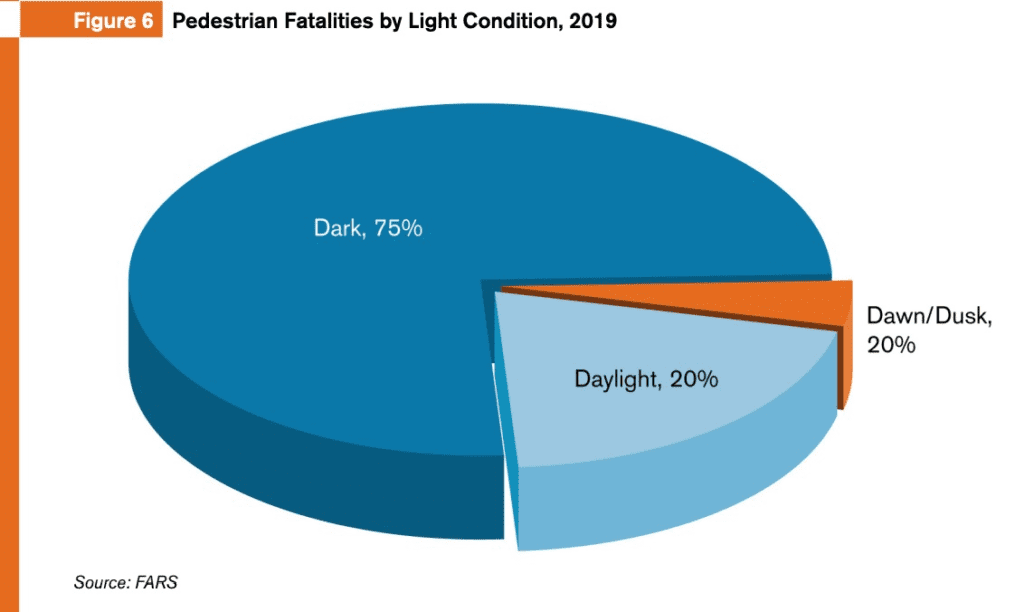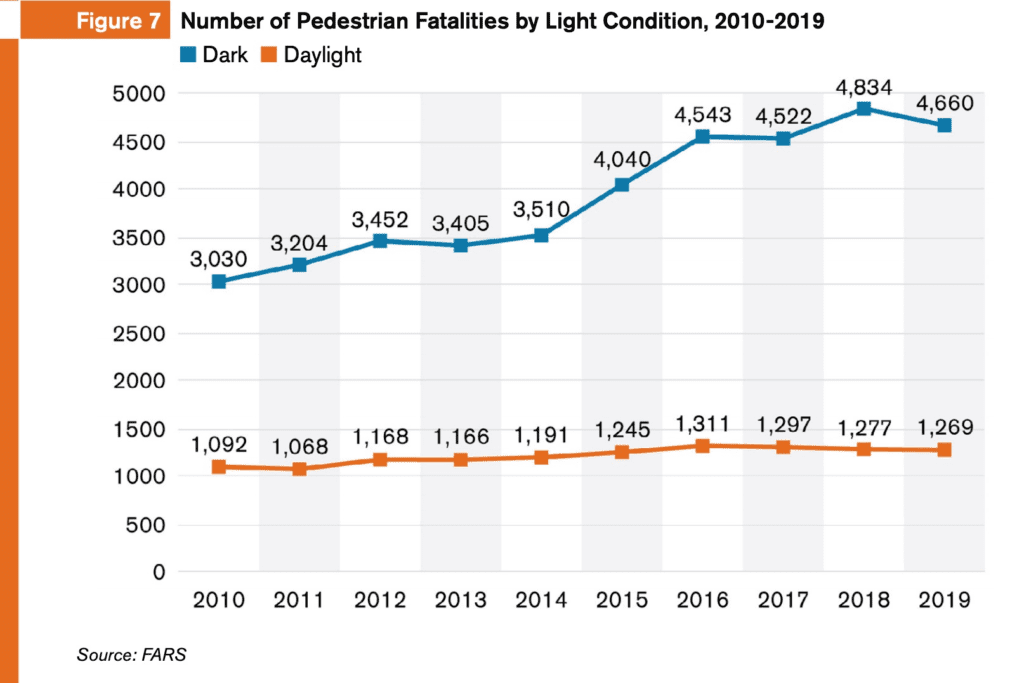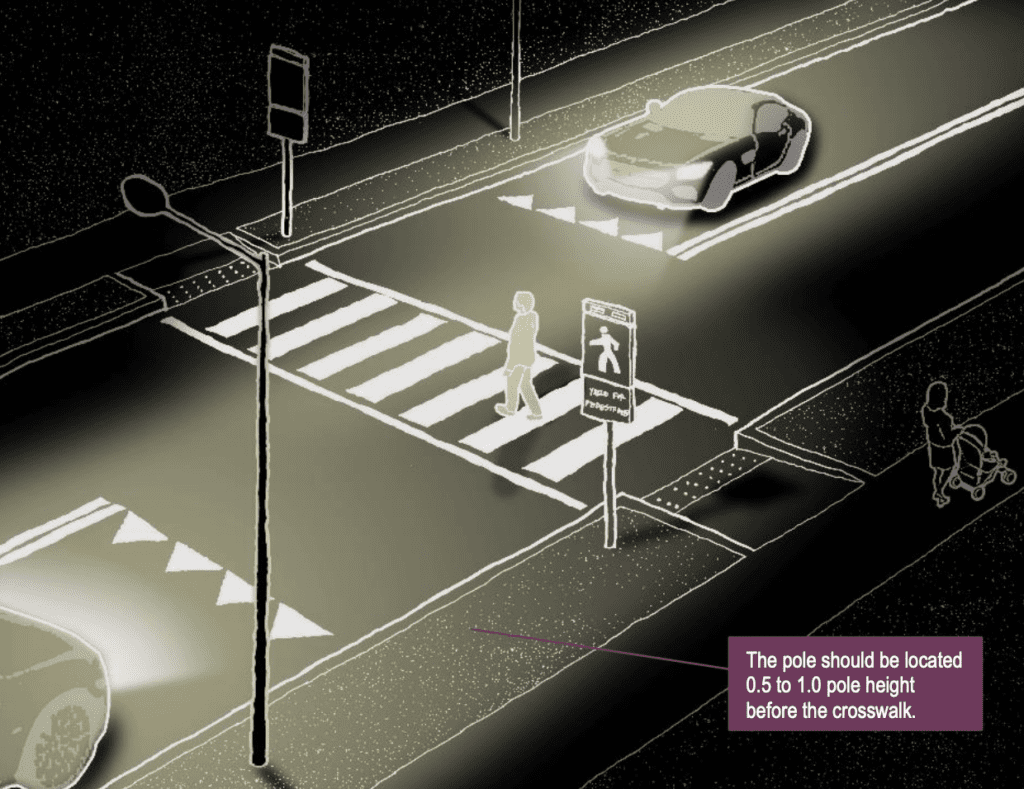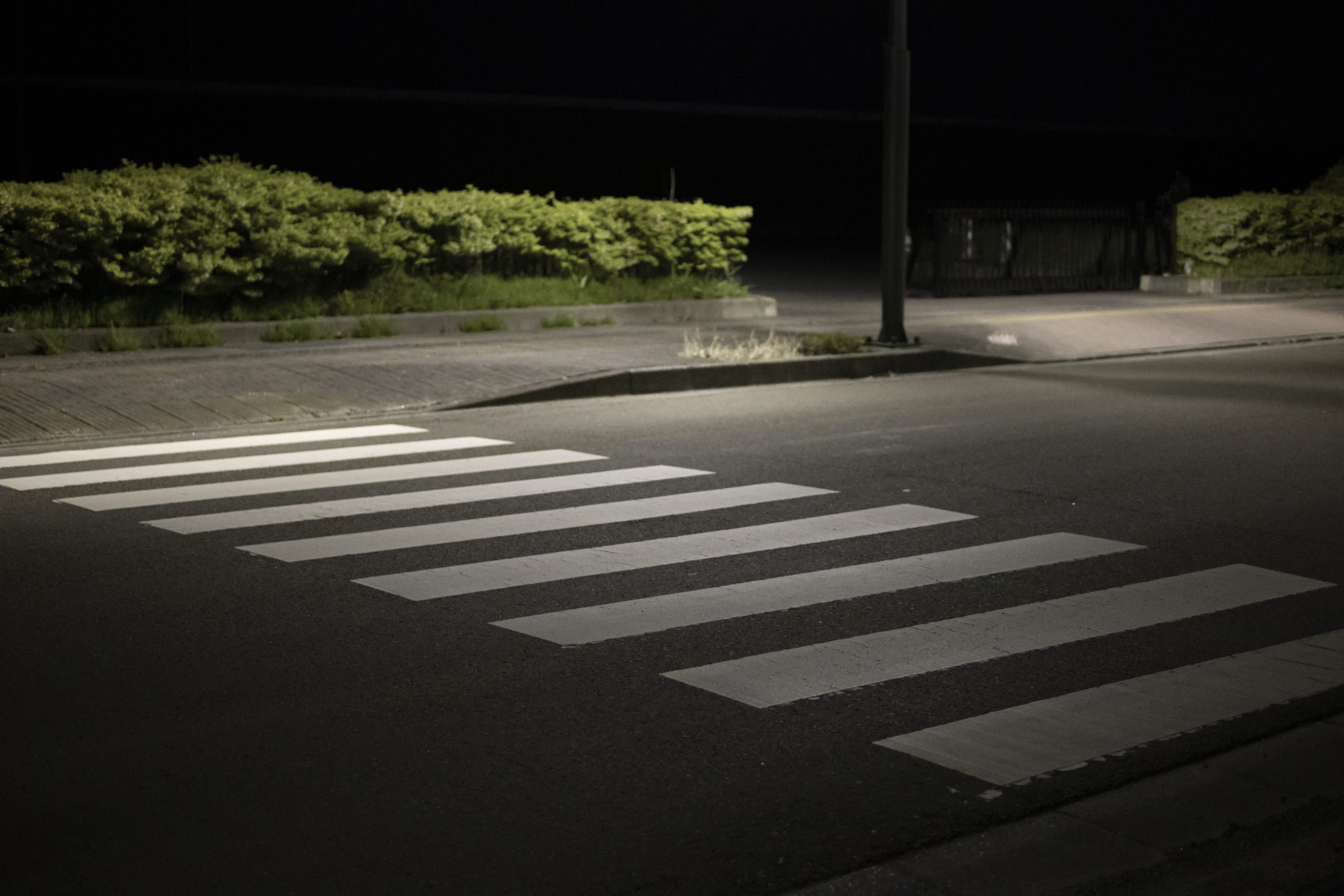It’s increasingly dangerous to be a pedestrian in many parts of the country, and especially at night.
75% of pedestrian fatalities in the U.S. happen at night.

In the decade leading up to 2019, the number of pedestrian fatalities that occurred during the daytime remained relatively flat, while the number of nighttime pedestrian fatalities rose 54%.

By 2019, most pedestrian fatalities (74%) also occurred at non-intersection locations—pedestrians crossing roadways at more convenient, mid-block (and, thus, not well-lit) points.
Engineers and agencies across the country have been asking why this increase is happening and how we can make traffic safer for pedestrians.
3 Trends Leading to More Night-Time Pedestrian Crashes
Why the rates of pedestrian fatalities are increasing is the result of four clear trends:
- There are more pedestrians. More and more people are commuting on foot in recent years. Some of this increase is in large cities, but some of it is taking place in smaller communities where agencies have fewer resources.
- More people are working at night. Not only are there more pedestrians, there are more nighttime pedestrians. This increases foot traffic and pedestrian crossings where agencies are not well-equipped and motorists are not used to seeing pedestrians.
- Collision avoidance systems in new vehicles might not be as effective as manufacturers claim, especially at night time. They have been aggressively marketed, however, especially as safety nets in the dark or in inclement weather, so motorists rely too heavily on them.
All of these factors combine to create the perfect storm for pedestrians in our neighborhoods.
Solution: Crosswalk Visibility Enhancements
Accidents on unlit or poorly lit roads are almost twice as likely to be fatal as those on well-lit roads and intersections. Modern crosswalk visibility enhancement strategies have been proven to reduce pedestrian crashes by up to 48%.
And modern, effective visibility is more than street lights. Typical street lights are 25 feet high and 100 feet (or more) apart. They leave a lot of shadows on the road and don’t produce the right kind of illumination. Street lights are designed to serve the needs of motorists, but not to illuminate a pedestrian or light an entire crosswalk area.
2 Components of Pedestrian Visibility
Adequate, life-saving pedestrian visibility has to consider two factors: contrast and vertical illuminance.
Contrast
Contrast is the visible difference between an object and its background. There are two types of contrast: positive and negative. Positive contrast occurs when an object is brighter than its background, and negative contrast describes an object that is darker than its background (a silhouette). Positive contrast on a pedestrian is the goal of modern visibility enhancements.
Historically, the use of silhouette or negative contrast for the detection of a pedestrian was recommended. However, new research is showing positive contrast has many advantages … – Illuminating Engineering Society
This means that crosswalk lighting strategies have to consider the visual background from the perspective of the on-coming motorist. Bright roadways or bright off-road installations (gas stations, etc.) increase background luminance and either reduce contrast or create negative contrast on the pedestrian—making them more difficult for motorists to see.
Vertical Illuminance
Vertical illuminance is the amount of light that falls on (and bounces off of) a vertical surface—for our purposes, the profile of a pedestrian.
A vertical illuminance of 20 lux, at 5 feet from the ground, across the entire roadway, is necessary for motorists to see pedestrians in mid-block crosswalks, at sufficient distances, in rural conditions. Higher levels of illuminance may be necessary if there is a steady glare from oncoming vehicles or if there are high levels of ambient light.
The goal in designing crosswalk visibility enhancements is to maximize the positive contrast and vertical illuminance of pedestrians on or near a crosswalk, from the perspective of an oncoming driver.
Overhead Lighting Design Principles and Guidelines
As you start designing a photometric layout, there are three key principles of lighting design to be familiar with.
Light Uniformity
Light uniformity is the ratio of maximum-to-minimum or average-to-minimum illumination levels. A poor uniformity ratio, for example, would be an average-to-maximum of 5:1, where the brightest parts of the crosswalk are five times brighter than the darkest parts.
The goal of a good lighting schematic is a 1:1 ratio, an even spread throughout the crosswalk. This kind of high visibility ensures better contrast across the pedestrian’s entire path.
Designing for Light Uniformity
Light uniformity is important for both positive contrast and adequate vertical illuminance. Most agencies recommend a maximum contrast of 4:1. The IES recommends nothing greater than a 3:1 ratio.
The best way to achieve effective light uniformity is to add overhead lights at crosswalks. LED lights produce light from multiple, discrete sources, rather than from one fixed point, creating much lower uniformity ratios.
Type III optics allow for more uniformity and proper directional lighting on the pedestrian for adequate vertical illuminance.
Glare
Glare is excessive brightness that causes discomfort or impairment of vision.
Glare is caused by lights that are non-directional or unshielded. They give off “spilled light,” which produces glare and/or light trespass into nearby homes and businesses. (Spilled light also wastes energy, disrupts sleep patterns, impacts nocturnal wildlife, and contributes to light pollution, so it’s best avoided for all kinds of reasons.)
Designing to Avoid Glare
Flood lights are effective for lighting an area, but terrible for producing glare. In order to install overhead lighting at crosswalks, but avoid spilled light and glare, the IES recommends flat glass lumens, mounted with light parallel to the ground.
Area Lighting
Area lighting is simply light where you need it. As you design photometric layouts for your crosswalks, consider entry and exit areas as well.
We’ve seen that pedestrians don’t always cross directly on the crosswalk. Even at an intersection, pedestrians will often cut a corner off the curb or around a pole and enter the roadway just before or just after the crosswalk. Some DOTs, actually require area lighting in a five foot radius at the entry and exit points, as well as the length of the crosswalk.
Designing for Area Lighting
A key design principle for both light uniformity and area lighting is the placement of overhead lights. Agencies have traditionally positioned street lights or other overhead lighting directly over the crosswalk, but this creates more negative contrast than positive, provides almost no vertical illuminance, and fails to light entry and exit points well.
New guidelines recommend placing lighting fixtures about 10 feet before the crosswalk, from the perspective on oncoming traffic.

Fixtures in front of the crosswalk provide about 20 lux of vertical illuminance across the roadway and help to illuminate the crosswalk entry point. The exact, ideal distance between the pole and crosswalk will vary, based on the environment and other lighting conditions.
How to Spec a Lighting Upgrade: Key Considerations
When you’re ready to start putting together some specs to upgrade crosswalk visibility, here are the particulars to consider:
- Preferred model — Do you want solar power or a cabinet? A lot of modern crosswalk safety poles are equipped with RRFBs and LED-enhanced signs, powered by solar. Overhead crosswalk lighting can also be solar-powered, saving a lot of maintenance needs.
- Preferred configuration — How many lights do you need on the pole? You may need an overhead light that stretches over the crosswalk and another that stretches back over the entry point. If you don’t already have flashers or other warning lights at the crosswalk, now might be a good time to install those as well.
- LED type and quantity — How wide is the roadway? What other lighting conditions are you competing with? Wider roads and more glare will require brighter lights at the crosswalk.
- Preferred activation — The lights can be on a push-button or active detection sensor, or both: maybe the overhead light comes on when a pedestrian is detected at night, but the flashers are user-activated.
- Usage — There are a number of usage considerations that will affect what kind of lights and power you need, as well. How long does the flash duration need to be? How many daily activations do you expect? What percent of activations do you expect at night? What kind of obstructions—trees, buildings, etc.—are near the crosswalk?
Carmanah has a complete suite of pedestrian safety signs and lighting, to help every agency design the solution they need. Their RRFBs, flashing beacons, and LED-enhanced crosswalk signs are available as solar-powered solutions. Overhead crosswalk lights can be added to any configuration.
Crosswalk Lighting to Reverse Pedestrian Fatality Trends
The increasing rates of pedestrian fatalities, and even just the growing trend of nighttime pedestrian traffic, is a concern for agencies. As you work to add crosswalks at desire paths and upgrade safety measures, overhead lighting—according to updated guidelines—should be a primary consideration.
Carmanah is an industry leader in crosswalk safety installations and our teams at Western Systems have been working with their systems for years. We have partnered with agencies across the Western U.S. to increase pedestrian safety in countless situations. When you’re ready to get started, call us at 425-438-1133 or contact us online.

